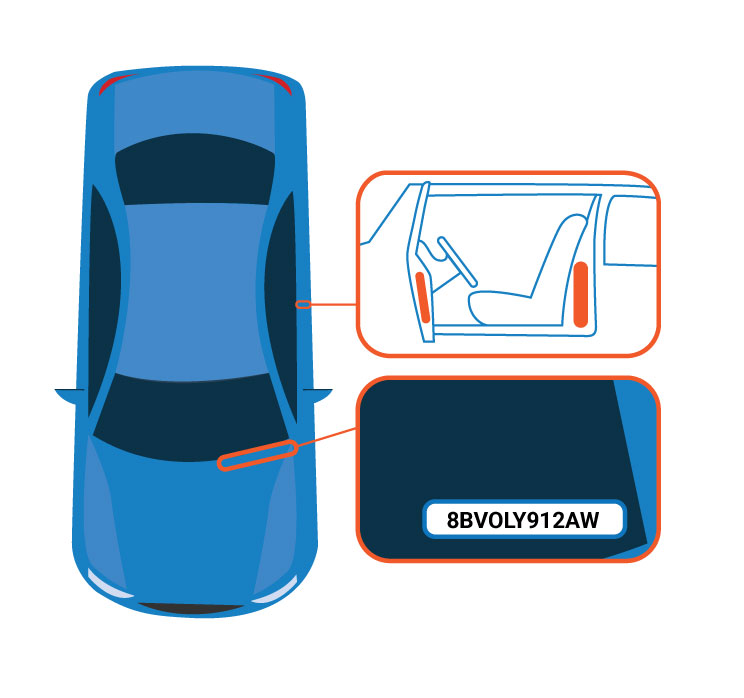Vehicle Identification Number (VIN)
Every vehicle has a unique VIN. Enter a VIN to learn if a specific vehicle needs to be repaired as part of a recall.
You have been redirected to this page because NHTSA's VIN search tool may be experiencing intermittent disruption due to routine maintenance, slow manufacturer response or heavy traffic to this page. To ensure you get the important information you are seeking, you can click on the appropriate vehicle maker below to go to its VIN search tool.<br /><br />
You can also contact our Vehicle Safety Hotline at 1-888-327-4236 for assistance. We apologize for any inconvenience and thank you for your patience.
Light Vehicle Manufacturers
Motorcycle Manufacturers
Where's my VIN?
Look on the lower left of your car's windshield for your 17-character Vehicle Identification Number. Your VIN is also located on your car's registration card, and it may be shown on your insurance card.

What this VIN search tool will show
- An unrepaired vehicle affected by a vehicle safety recall in the past 15 calendar years
- Vehicle safety recalls from major light auto automakers, motorcycle manufacturers and some medium/heavy truck manufacturers
What this VIN search tool will not show
- A vehicle with a repaired safety recall. If your vehicle has no unrepaired recalls, you will see the message: "0 Unrepaired recalls associated with this VIN"
- Manufacturer customer service or other nonsafety recall campaign
- International vehicles
- There may be a delay with very recently announced safety recalls for which not all VINs have been identified. VINs are added continuously so please check regularly.
- Safety recalls that are more than 15 years old (except where a manufacturer offers more coverage)
- Safety recalls conducted by small vehicle manufacturers, including some ultra-luxury brands and specialty applications
Check your vehicle safety
Also search by NHTSA ID or complaints by keyword.
The Steps From Complaint To Recall
What happens to my complaint?
Your complaint fuels our work. Learn about the different steps that lead to recalls and safer vehicles.
The Steps From Complaint To Recall PDF, 5.56 MB
From your complaints
to recall campaigns
NHTSA issues vehicle safety standards and requires manufacturers to recall vehicles and equipment's that have safety-related defects. Learn about NHTSA's recall process.
Complaints
Reporting your problem is the important first step.
Your complaint will be added to a public NHTSA database after personally identifying information is removed.
If the agency receives similar reports from a number of people about the same product, this could indicate that a safety-related defect may exist that would warrant the opening of an investigation.
Example of ComplaintsHave a safety problem?
Report a problem with your vehicle, tires, car seats or other equipment. We review every problem as we work to keep our roads safe.
Report a safety problemInvestigations
NHTSA conducts an investigation from reported complaints.
A. SCREENING
NHTSA reviews filed complaints from vehicle owners and other information related to alleged defects to decide whether to open an investigation.
B. ANALYSIS
NHTSA conducts an analysis of any petitions calling for defect investigations. If the petition is denied, the reasons for the denial are published in the Federal Register.
C. INVESTIGATION
NHTSA opens an investigation of alleged safety defects. It is closed when they notify the manufacturer of recall recommendations or they don’t identify a safety-related defect.
D. RECALL MANAGEMENT
NHTSA reviews filed complaints from vehicle owners and other information related to alleged defects to decide whether to open an investigation.
View monthly investigation reportsRecalls
Initiated safety recalls require a manufacturer's action to announce and remedy the defects.
A recall is issued when a manufacturer or NHTSA determines that a vehicle, equipment, car seat, or tire creates an unreasonable safety risk or fails to meet minimum safety standards. Most decisions to conduct a recall and remedy a safety defect are made voluntarily by manufacturers prior to any involvement by NHTSA.
Manufacturers are required to fix the problem by repairing it, replacing it, offering a refund, or in rare cases repurchasing the vehicle. View the 2019 Recall Report.
Using our VIN lookup tool, you can access recall information provided by the manufacturer conducting the recall which may be not posted yet on NHTSA’s site.
Go to search by VINTakata Recalls Spotlight
The latest updates on Takata recalls
Recalls Spotlight monitors high-profile recalls and offers consumers resources to find and address vehicle recalls.
Takata Recall SpotlightMotor Vehicle Safety Defects And Recalls - What Every Vehicle Owner Should Know
Download this brochure to get more information about how and why recall campaigns are initiated, and to know your rights and responsibilities when a vehicle or item of motor vehicle equipment is recalled.
Sign Up for Recall Alerts via Email
Know if there is a safety problem with your vehicles, tires or car seat, and how to get it fixed.
 United States Department of Transportation
United States Department of Transportation